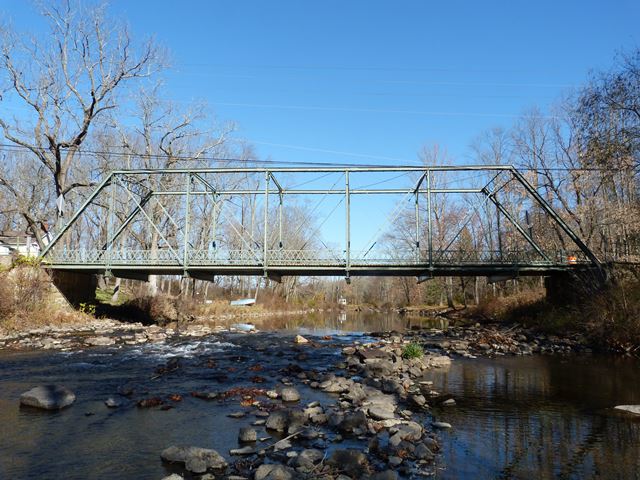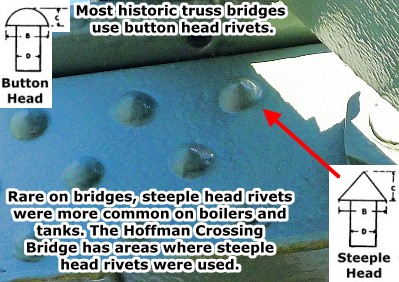We Recommend:
Bach Steel - Experts at historic truss bridge restoration.
BridgeHunter.com Phase 1 is released to the public! - Visit Now
Hoffman's Crossing Bridge

Primary Photographer(s): Nathan Holth
Bridge Documented: November 7, 2015
Rural: Hunterdon County, New Jersey: United States
1898 By Builder/Contractor: Tippett and Wood of Phillipsburg, New Jersey
1994
103.0 Feet (31.4 Meters)
104.0 Feet (31.7 Meters)
16 Feet (4.88 Meters)
1 Main Span(s)
10XX140

View Information About HSR Ratings
Bridge Documentation
View Archived National Bridge Inventory Report - Has Additional Details and Evaluation
View A Historical Biography of James Whitfield Wood
View A 1916 Product Catalog For Tippet and Wood

This bridge is a traditional pin-connected Pratt through truss. Overall historic integrity is fair, but welded alterations are present and floorbeams are not original. The struts appear to have been replaced which is the most substantial alteration from a historic significance standpoint. The existing struts are unusual variable depth design and at first glance this might make them seem original, but they are welded onto the bridge. One unusual detail on the bridge is the use of steeple head rivets in many areas instead of the button head rivets usually used on truss bridges.
This bridge is noteworthy for being associated as the work of Tippett and Wood. This small, local company actually specialized in the construction of water towers and tanks. By 1916, they no longer built bridges at all, as bridges are not even mentioned in a company catalog from that year. However this bridge shows in the 19th Century the company did build bridges.
The Historic Bridge Inventory noted that among bridges surveyed in New Jersey this was the only bridge documented as having been built by Tippett and Wood. However, HistoricBridges.org suspects that among the bridges listed in New Jersey on this website, there may very well additionally be undocumented bridges that are the work of this company. During documentation of New Jersey, HistoricBridges.org identified a number of bridges that displayed unusual details, the sort of details that are typically unique to a particular company. However, these details were not known to be the work of any well-known bridge builder, and the Historic Bridge Inventory did not identify a builder for them. Given the regional concentration of "unknown builder" bridges with shared unusual details, it seems logical these bridges are the work of a single company, likely small and based locally. Most of the design details that these bridges display are not shared among all bridges: some display cast iron decorative elements for example while others did not. All of them did share one detail however, which was the use of a steeple head rivets, which are rare on bridges, which usually use button head rivets. Steeple head rivets are usually found on tanks and boilers. This is interesting because Tippett and Wood (a small, local company) built tanks and boilers as their main line of business. So if any company were to use steeple-head rivets on bridges, a company that specialized in tanks and boilers would be the most likely to do this. It may be that this group of "unknown builder" bridges noted by HistoricBridges.org are all the work of Tippett and Wood.

Information and Findings From New Jersey's Historic Bridge InventorySummary The 7-panel pin-connected Pratt thru truss bridge is a remarkably complete example of its type. It is supported on random ashlar abutments. The stone wingwalls are topped with pipe railings. Verticals are laced and portals are latticed. Lattice railings remain. Top struts and knee bracing have been reinforced with welded plates. The few repairs noted are unobtrusive and do not compromise the original fabric of the bridge. The nearly unaltered bridge enjoys integrity of setting and design. Setting/Context The bridge carries one lane of a quiet rural road over the South Branch of the Raritan River. It is located in a wooded rural setting adjacent to well-maintained 19th-century homes. Green space adjacent to the bridge provides it with a park like setting. The picturesque setting of the bridge contributes to its significance. Physical Description The seven-panel, pin-connected, full hip Pratt truss bridge is remarkably well preserved. The top chord is composed of channels, toe out and cover plates with lacing. The bottom chords consist of stamped eyebars. Verticals are composed of channels with lacing on each side. The diagonals are stamped eyebars while the counters are rods. The portals are latticed with A knee bracing. Floor beams are hung using U-bolt hangers. The original lattice web railings remain. The bridge is supported on ashlar abutments with wingwalls finished with pipe railings. According to county records, the abutments were repaired in 1967 and the wingwalls were re-pointed in 1975. The corrugated steel deck with asphalt overlay was added in 1970. Lateral bracing has been welded to the top chords, and knee bracing has been welded to each vertical and lateral brace. Historical and Technological Significance The nearly unaltered pin-connected Pratt thru truss bridge is the only documented example of the work of a small New Jersey fabricator, Tippett and Wood (criterion C). According to Victor Darnell, this Phillipsburg (Warren County) firm was established in 1868 and operated until at least 1901. Although the bridge does not exhibit any unusual design details, it is a well-preserved example of an important late-19th century bridge type. Its significance is enhanced by the fact that it is documented as being the work of a little-known local fabricator. The bridge, located adjacent to a well-preserved Hoffman home dating to the 19th century, enjoys integrity of setting and design. Boundary Description and Justification The bridge is individually distinguished and it is located in or on the border of a potential historic district. Thus the span and the area adjacent to the abutments is significant. The limits of the potential historic district were not defined in this survey. Sources Hunterdon County Engineer's Office, Bridge Card L140. Hunterdon County Master Plan: Sites of Historic Interest, 1979. Darnell, Victor C. A Dictionary of American Bridge-Building Companies, 1840-1900. Washington, D.C.: Society for Industrial Archeology, 1984. Bridge Considered Historic By Survey: Yes |
![]()
Photo Galleries and Videos: Hoffman's Crossing Bridge
Bridge Photo-Documentation
Original / Full Size PhotosA collection of overview and detail photos. This gallery offers photos in the highest available resolution and file size in a touch-friendly popup viewer.
Alternatively, Browse Without Using Viewer
![]()
Bridge Photo-Documentation
Mobile Optimized PhotosA collection of overview and detail photos. This gallery features data-friendly, fast-loading photos in a touch-friendly popup viewer.
Alternatively, Browse Without Using Viewer
![]()
Maps and Links: Hoffman's Crossing Bridge
Coordinates (Latitude, Longitude):
Search For Additional Bridge Listings:
Bridgehunter.com: View listed bridges within 0.5 miles (0.8 kilometers) of this bridge.
Bridgehunter.com: View listed bridges within 10 miles (16 kilometers) of this bridge.
Additional Maps:
Google Streetview (If Available)
GeoHack (Additional Links and Coordinates)
Apple Maps (Via DuckDuckGo Search)
Apple Maps (Apple devices only)
Android: Open Location In Your Map or GPS App
Flickr Gallery (Find Nearby Photos)
Wikimedia Commons (Find Nearby Photos)
Directions Via Sygic For Android
Directions Via Sygic For iOS and Android Dolphin Browser
USGS National Map (United States Only)
Historical USGS Topo Maps (United States Only)
Historic Aerials (United States Only)
CalTopo Maps (United States Only)

